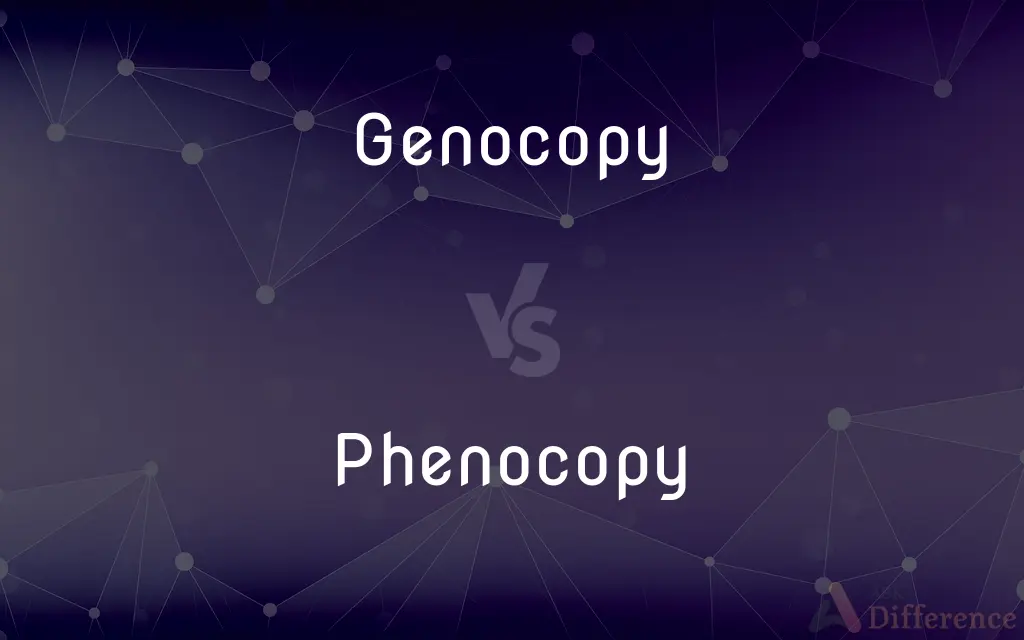Genocopy vs. Phenocopy — What's the Difference?
By Tayyaba Rehman & Maham Liaqat — Updated on March 15, 2024
A genocopy is a genetic trait mimicking another, due to different genes, whereas a phenocopy appears due to environmental factors, not genetics.

Difference Between Genocopy and Phenocopy
Table of Contents
ADVERTISEMENT
Key Differences
Genocopies arise when different genes produce similar phenotypes, highlighting the complexity of genetic interactions. Whereas phenocopies result from environmental influences, showcasing how external conditions can mirror genetic traits.
While genocopies are inherited and can be passed down through generations, phenocopies do not alter the genetic makeup and are not inheritable, emphasizing the temporary nature of environmental effects.
Genocopies often contribute to the study of genetic linkage and epistasis, revealing the intricate relationships between different genes. On the other hand, phenocopies are key in understanding phenotypic plasticity, demonstrating an organism's ability to change its phenotype in response to environmental changes.
In medical research, genocopies help identify genetic disorders that may present similarly due to different genetic causes. Conversely, phenocopies are important in epidemiology and toxicology, providing insights into how environmental factors can induce disease-like states.
Genocopies require genetic testing for accurate identification, relying on the understanding of genetic inheritance patterns. Phenocopies, however, can often be identified through changes in environmental exposure or conditions, highlighting the importance of environmental history.
ADVERTISEMENT
Comparison Chart
Basis of similarity
Different genes causing similar phenotypes
Environmental factors mimicking a genetic trait
Inheritance
Yes, can be inherited
No, not inheritable
Role in research
Used to study genetic interactions and linkage
Helps in understanding environmental impacts on phenotype
Identification
Requires genetic analysis
Often identified by changes in environment or exposure
Reversibility
Permanent, unless gene is altered
Often reversible if environmental condition changes
Compare with Definitions
Genocopy
An inherited phenotype that resembles another, due to distinct genetic causes.
Different genetic mutations can lead to similar eye color, a classic case of genocopy.
Phenocopy
A temporary change in an organism's phenotype due to external influences.
Tanning from sun exposure is a phenocopy that mimics darker skin genetics.
Genocopy
A genetic condition where different genes result in similar traits or diseases.
Two siblings might have similar genetic disorders due to different mutated genes, showcasing genocopy.
Phenocopy
A phenotype produced by environmental factors that mimic a genetic condition.
Malnutrition can lead to stunted growth, a phenocopy of genetic dwarfism.
Genocopy
The phenomenon where one gene's effect is mimicked by another, different gene.
In fruit flies, wing shape altered by different genes is an example of genocopy.
Phenocopy
An environmentally induced trait or condition resembling a genetic phenotype.
Exposure to certain chemicals can cause changes in skin pigmentation, a phenocopy of genetic skin conditions.
Genocopy
An instance of genetic convergence resulting in similar phenotypes.
Genocopy can occur in species evolution, where unrelated genes lead to similar adaptations.
Phenocopy
Non-heritable phenotypic changes that resemble genetic traits.
Parrots with feather colors changed by diet are exhibiting phenocopy, not genetic coloration.
Genocopy
A genetic mimicry that complicates the understanding of hereditary diseases.
Genocopy complicates diagnosing genetic disorders, as different genes can cause similar symptoms.
Phenocopy
The mimicry of genetic disorders through environmental or external factors.
Certain medications can cause symptoms mimicking genetic neurological disorders, a form of phenocopy.
Genocopy
Genocopy is a trait that is a phenotypic copy of a genetic trait but is caused by a different genotype. When a genetic mutation or genotype in one locus results in a phenotype similar to one that is known to be caused by another mutation or genotype in another locus, it is said to be a genocopy.
Phenocopy
A phenocopy is a variation in phenotype (generally referring to a single trait) which is caused by environmental conditions (often, but not necessarily, during the organism's development), such that the organism's phenotype matches a phenotype which is determined by genetic factors. It is not a type of mutation, as it is non-hereditary.
Genocopy
A trait that is a phenotypic copy of a genetic trait but is caused by a different genotype
Phenocopy
An environmentally induced, nonhereditary trait in an organism that closely resembles a genetically determined trait, especially a mutation.
Genocopy
(genetics) To make such a copy
Phenocopy
An individual exhibiting such a trait.
Phenocopy
(genetics) A variation in an organism that resembles a genetic one, but has an environmental rather than a genetic cause, and is not inherited
Phenocopy
(genetics) To copy a genetic variation through environmental manipulation
Common Curiosities
Are phenocopies inheritable?
No, phenocopies are not inheritable as they do not involve changes to the genetic code.
What is a phenocopy?
A phenocopy is a phenotype induced by environmental factors that mimic a genetic trait.
What role do phenocopies play in medicine?
Phenocopies can help understand how environmental factors contribute to disease states, aiding in diagnosis and treatment.
Can phenocopies be reversed?
Often, yes, since they are caused by environmental factors, changes in these factors can reverse phenocopies.
How do genocopies contribute to genetic research?
Genocopies are crucial for understanding genetic linkage, epistasis, and the complexity of genetic diseases.
Can genocopies be inherited?
Yes, genocopies can be inherited as they are based on genetic information.
Do genocopies affect phenotype?
Yes, genocopies affect the phenotype by producing traits similar to those caused by other genes.
Is genetic testing effective for identifying phenocopies?
No, genetic testing is not effective for phenocopies since they are not caused by genetic variations.
What is a genocopy?
A genocopy is a phenotype resulting from different genetic causes that resemble another genetic trait.
How do environmental factors lead to phenocopies?
Environmental factors like temperature, nutrition, and chemicals can induce changes in an organism's phenotype, mimicking genetic conditions.
What is the main difference between genocopies and phenocopies?
The main difference lies in their cause: genocopies are due to genetic factors, whereas phenocopies are due to environmental factors.
Can a single trait be both a genocopy and phenocopy?
A single trait can appear as a genocopy in one context (due to genetic reasons) and as a phenocopy in another (due to environmental reasons).
What is the significance of phenocopies in biology?
Phenocopies highlight the role of environmental factors in phenotype expression and phenotypic plasticity.
How are genocopies identified?
Genocopies are identified through genetic testing and analysis of inheritance patterns.
Can phenocopies occur in all organisms?
Phenocopies can occur in any organism capable of phenotypic plasticity in response to environmental changes.
Share Your Discovery

Previous Comparison
Gyro vs. Taco
Next Comparison
Employee vs. AgentAuthor Spotlight
Written by
Tayyaba RehmanTayyaba Rehman is a distinguished writer, currently serving as a primary contributor to askdifference.com. As a researcher in semantics and etymology, Tayyaba's passion for the complexity of languages and their distinctions has found a perfect home on the platform. Tayyaba delves into the intricacies of language, distinguishing between commonly confused words and phrases, thereby providing clarity for readers worldwide.
Co-written by
Maham Liaqat















































